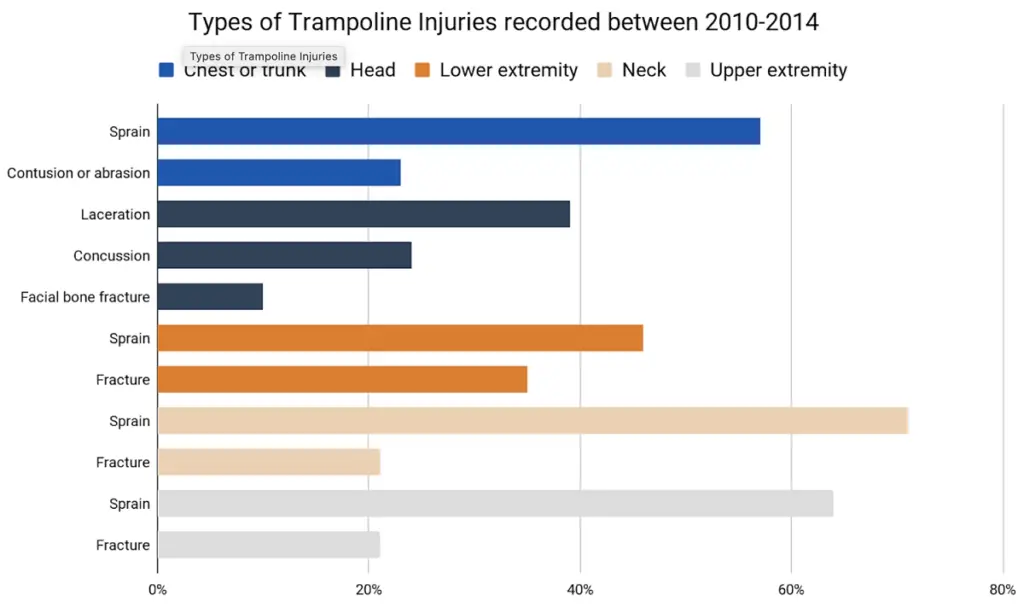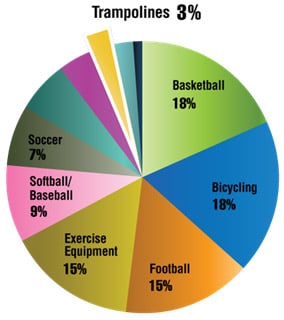To have a trampoline in the backyard is fun yet there are some risks and dangers involved, that’s why a trampoline is called an expensive nuisance sometimes. Every year, thousands of trampoline injuries occur in the USA only and it’s increasing frequently that’s really alarming.
According to the advice of the American Academy of Pediatrics, trampolines are highly dangerous for kids and should be abandoned by US people as soon as possible. Even they tried to hold back the selling of tramps from the market. But still, we can’t resist ourselves from having one for our children, even for us to have some fun exercise in the yard.
Probably the trampoline injury statistics may make change your mind or at least make you rethink the decision about the trampoline purchase. Let’s read the full article on this.
Causes of Trampoline Injuries and Deaths
So, after getting a lot of stats on trampoline injuries, let’s get to know some reasons for this unfortunate event. Though a bit of them has already been discussed, let’s take a look at all of them.
According to the U.S. Consumer Product Safety Commission (CPSC), there are four main reasons for trampoline injuries or deaths.
- Jumping with a group of people on a trampoline. Studies say that more than 75% of injuries and 90% of fracture patients are caused by multiple kids jumping on one trampoline.
- Landing in a wrong posture or out off the trampoline. About 27% to 39% of trampoline injuries are caused because of unpredicted falls.
- Doing inexperienced stunts
- Falling on the frame or springs of the trampoline. 20% of the injuries are caused for the direct fall on trampoline springs or frames.
Read Also: Different negative effects of trampolining and rebounding
Most Common Trampoline Injuries
Trampoline injuries are unpredictable. You don’t know where you are going to get hurt until banging into the ground in the wrong postures. Trampoline injuries are not actually about the jump, it’s about the landing posture. Just a small slip of step, any type of injury can occur.
Starting from small bruises to bigger fractures, trampoline injuries can be any kind or anywhere. And even a reckless bump on the head can also lead to death. So, there are thousands of possibilities to get hurt.
But the most common types of trampoline injuries are-
- Cuts and puncture wounds
- Bruises and broken bones
- Sprains
- Strains
- soft tissue damage
- spinal cord injury
- Ankle injuries
- Fractures
- Head injuries
- Neck injuries
- Paralysis
- Death (worst trampoline injuries)
Although these injuries, mostly occur at home trampolines rather than the park ones. Trampoline Park owners primarily have themselves covered from any kind of accident happening.
Although when the injuries happen in a public appearance, they are kind of big according to the American Academy of Orthopedic Surgeons. And when more than one person is jumping in that nasty mat, it’s going to create big-shot injuries.
The following chart shows trampoline injuries recorded between 2010 to 2014

National Library of Medicine illustrates trampoline injury rates with injury cause (table 1) and the location of the injury (table 2). Here we’re also mentioning it for easy understanding of our readers.
Table 1: Main cause of injury
| Reason of injury | Number (%) |
| Awkward landing on the trampoline | 292 (53) |
| Fall off the trampoline | 122 (22) |
| Collision with another person | 73 (13) |
| Performing a somersault | 59 (11) |
| Other | 5 (1) |
| Unknown | 5 (1) |
| Total | 551 (100) |
Table 2: Location of injury
| Location of injury | Number (%) |
| Head | 49 (9) |
| Neck | 46 (8) |
| Trunk/back | 24 (4) |
| Shoulder | 8 (1) |
| Upper arm | 8 (1) |
| Elbow | 62 (11) |
| Forearm | 36 (7) |
| Wrist/hand | 77 (14) |
| Hip/thigh | 10 (2) |
| Knee | 49 (9) |
| Leg | 15 (3) |
| Ankle | 141 (25) |
| Foot | 31 (6) |
| Total | 556 (100) |
Read Also: Is rebounding bad for back?
Statistics on Trampoline Injuries

Already said, there are thousands of trampoline injuries occurring in the USA every year. And springs and summer are the peak time for finding trampoline injury cases in hospitals.
For a better understanding of the trampoline danger statistics, the number is 100,000 cases treated every year in the emergency room between 2002 and 2011. Also, about 500 cases of them lead to permanent neurologic damage.
So, if you sum up the number of injuries, it’s more than 1 million people who were treated in the emergency rooms (ER) for trampolines in those 10 years. And about 300,000 of those cases were of broken bones. Sadly, 92.7% of the fracture case victims were under 16 or less.
Even 15% of approximate trampoline injury victims are children under 6, from which 37% of the children are treated in the ER. This clearly shows that young kids are mostly laying the highest risk of trampoline injuries.
The same thing is highlighted in the AAP report that says the same that younger children are at 14 times more risk than adults.
Also, 95.1% of trampoline fracture cases happened at home and the rest are in trampoline parks or gymnasts. Another stat mentioned in BrainandSpinalCord.org says, around 20 percent of all spinal cord injuries of the head and neck were from trampoline accidents.
And if you count the small strains, sprains and contusions kind of injuries, about 40% of those injuries are caused from trampoline falls. And also, 4% of the patients have to take a little extra hospital care by staying.
According to the estimation of U.S. Consumer Product Safety Commission (CPSC), there were 104,691 trampoline injury cases treated in the hospital emergency room in 2014 which has increased in four years to 110,000. Also, the CPSC report said that there were 22 deaths of kids between 2000-2009 from trampoline accidents.
Even an after-report of the National Electronic Injury Surveillance System (NEISS) has shown a significant increase in trampoline fractures from an average of 3.85% between 2008 to 2017. Also, the same report says that 0.5% or one of every 200 trampoline injuries have led kids to permanent neurological damage from 2008 to 2017.
Moreover, further research on the lockdown era has shown a significant increase in trampoline injuries at home. According to a UK study, a rising spike has been seen in the trampoline injury in 2019.
Read Also: Trampoline has lots of benefits too
Trampoline Park Injuries vs Home Trampoline Injuries
Jumping on the home trampoline or park ones, both has a significant amount of trampoline risks to pose. If you want to be more cautious than these different reports of home trampoline and trampoline parks may help you in this decision-making.
According to research, home trampolines tend to have more risk than parks where you jump under the supervision of coaches or experts. But the injuries that happen in trampoline parks are more dangerous than home ones. So, all in all home or park you are going to face trampoline risks everywhere.
Coming to another trampoline danger statistics,66% of the trampoline injuries occurred in homes where the other 34% happened in trampoline parks. And in terms of facture ratio, the home trampoline fractures are 44% where the other 56% fractures are for park jumping.
Read Also: Is trampoline okay for pregnant?
Trampolines Injuries and Trampoline Types
Where AAP is trying to pause the sale of trampolines, there are more interesting types of trampolines are getting available in the market. The most common type of trampoline we see everywhere is the round one with which some brands also provide some netting too for safety purposes.
Also, there are some big rectangular trampolines that are mostly used in the parks or for gymnastics. Though there is a mini version of trampolines which people mostly use indoors for exercise. And their mini version doesn’t pose any danger like the big one.
Even the trampoline danger issue made the trampoline manufacturers so cautious that they came up with an in-ground trampoline. Though none of these mini or sunken versions has eliminated the hazard completely, but they lessen trampoline injury rates to some extent.
The following pie-chart illustrates trampoline and other Playsets injury rates.

Trampoline Insurance Facts
If you are a homeowner and want to have the backyard trampoline covered in your policy, first you have to clear the fact with your insurer. Many insurance companies don’t allow trampolines to have a trampoline covered by homeowner insurance.
Because of the excessive number of trampolines injuries, no companies want to cover trampoline in their policy. According to Insurance4USA.com, if any kid gets injured in your backyard trampoline, home insurance won’t cover any damages or legal costs.
Also, Families.com report says, if any insurance company finds a trampoline in your backyard, they can cancel the home insurance policy. But if any company allows the trampoline in your yard, then it will be categorized under an “attractive nuisance”.
And for getting the coverage you may have different categories to fit on.
- No special agreement on trampoline
- Proper safety measures should be covering the trampoline, for example a net, spring pad
- Exclude the trampoline from insurance
See Also: Tips to repair trampoline net
Tips to Avoid Trampoline Risks and Injuries
Just like the risks mentioned above, U.S. Consumer Product Safety Commission (CPSC) also provides some safety tips to avoid trampoline risks.
- First and foremost, rule is don’t allow jumping multiple kids on one trampoline neither in any supervision. As said three quarters of the trampoline injuries happen when multiple kids jump on the same trampoline. And not to forget, park injuries also occur when you jump with multiple people. So, for the sake of safety, enjoy trampolining alone.
- No stunts on trampoline without any expert supervision. Or it’s also best to not attempt any somersault without any experience. Or use safety equipment like spotters or harnesses to try some stunts.
- Cover all the springs, frames or any other hard object with pads. It’s even recommended not to place the trampoline in such a place where there is any hard floor or object like trees or posts nearby. Also, the trampoline should be placed in an equal place or at least make the ground leveled.
- Don’t allow kids under 6 to jump on a full-size trampoline. Not even in supervision.
- Remove the ladder from the trampoline to avoid children getting in tramps without supervision.
- It’s great to use safety nets for avoiding falls outside the trampoline.
- Keep watching on the trampoline for keeping track of any kind of hole or fixing needs.
- Jumping on centers only. Not in the sides or not even out off the trampoline.
- No jumping with shoes or socks as it doesn’t provide the proper grip on the mat.
- Using a sunken trampoline can lessen the risk of falling from high a little bit.
- Lastly, never leave your kids alone with this nasty big toy as children are unpredictable and can create a problem for themselves. Though trampoline accidents can also happen in the supervision of adults, if an adult closely supervises chances of risk are less.
Wrap Up
Trampoline injuries are more than we can count on hand. Which definitely is an alarming thing. But as we know danger signs never stop us from exploring the exciting fun time on tramps.
So that we discussed all the trampoline injury statistics, reasons, and their prevention tips, now it’s on your hand to buy a trampoline or not. Find your own ways to avoid the trampoline injury possibilities. Happy and safe trampolining!

Rebecca is a fitness nerd and mother. She was inspired to get into the world of trampolining and rebounding by her husband Robert, who is a well-respected trainer and expert in the field. Now she instructs children, mothers, and teens the basic trampolining and rebounding tricks.
Rebecca is also a passionate blogger, sharing her knowledge and experiences with others in the hope of encouraging them to give trampolining and rebounding a try.
